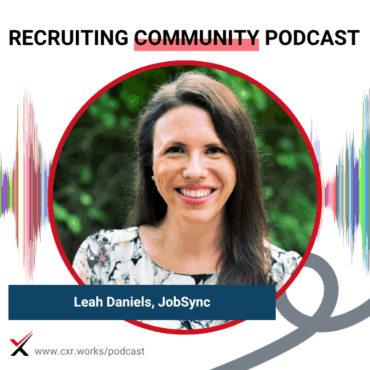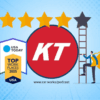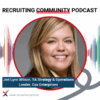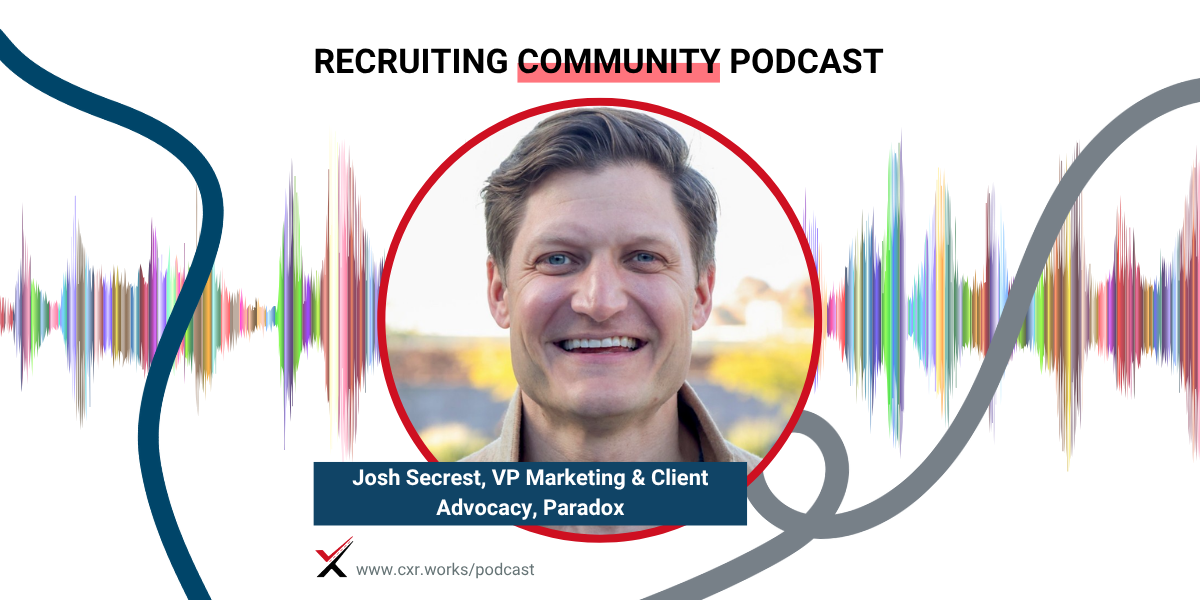
Trends to Watch for in 2025
What happens when AI tools help candidates apply to hundreds of jobs in seconds? We dive into the compliance mess, recruiter responses, and what’s next in 2025.
 play_arrow
play_arrow
How Kwik Trip Stays a Top Workplace – 16 Years Running Chris Hoyt
 play_arrow
play_arrow
Building Internal Mobility & Operational Impact at Cox Enterprises Chris Hoyt
 play_arrow
play_arrow
6,500 Hires & Beyond: AI, Agility, & Talent Strategy at Fontainebleau Las Vegas Chris Hoyt
 play_arrow
play_arrow
Navigating AI Hype & Culture Shifts in TA Chris Hoyt

Title:
Talent Acquisition as a Revenue Driver
Featured Guests:
Josh Secrest, Vice President, Paradox; Former Global Head of Talent Acquisition, McDonald’s
Hosts:
Chris Hoyt, President, CareerXroads
Gerry Crispin, Principal and Co-founder, CareerXroads
Episode Overview:
In this episode, the CXR team catches up with Josh Secrest to explore how automation is transforming talent acquisition across industries. Josh shares insights from his time leading global hiring at McDonald’s and his current role at Paradox, focusing on strategies for doing more with less, aligning TA with business outcomes, and leveraging automation to scale effectively. The discussion also touches on segmentation in hiring, ROI-driven decision-making, and emerging trends in scheduling and interview automation.
Key Topics:
Scaling hiring through automation at McDonald’s
ROI-focused TA strategies and financial alignment
Talent segmentation across distribution, frontline, and corporate roles
Adoption of automated scheduling and interview processes
Building a TA Ops function for metrics and process improvement
Budget challenges and confidence gaps among TA leaders
Future trends in professional hiring and quality focus
Notable Quotes:
“This costs $500K. Here’s how I’m saving $250K in media, $200K in process, and $50K in headcount.” — Josh Secrest
“We reduced hiring time from 21 days to 3 days, gave managers five hours back per restaurant, and saw big results.” — Josh Secrest
“Candidates apply to 15 jobs at once. The one that gets back to them first, with a confirmed interview, often wins.” — Josh Secrest
“You need to think like a CFO.” — Josh Secrest
“We’re done treating all jobs the same.” — Josh Secrest
Takeaways:
Josh Secrest highlights how aligning TA strategies with business outcomes—backed by automation and strong financial cases—can significantly improve hiring efficiency and impact. Leaders must embrace segmentation, prioritize speed and quality, and become fluent in ROI to navigate modern hiring challenges.
Want more conversations like this?
Subscribe to the CXR podcast and explore how top talent leaders are shaping the future of recruiting. Learn more about the CareerXroads community at cxr.works.
Chris Hoyt: All right, guys. It’s a new year. I’m super excited—we’re on, we’re live. Welcome, welcome. Good to see you, Josh.
Josh Secrest: Oh my gosh. Good to see you, Chris. Good to see you, Jerry.
Chris Hoyt: Yeah.
Josh Secrest: And, uh, Happy—
Chris Hoyt: New Year. Happy New Year. How long do we say “Happy New Year”? For a week? Yeah, this is it. You get one week.
Gerry Crispin: Okay, end of the—last day you can say “Happy New Year.” Tomorrow. Yes. Tomorrow, you start something else.
Chris Hoyt: Tomorrow, all emails start with, “Hey, same stuff…” Can’t say that! Did you guys form any big resolutions? Josh, did you put anything together from a resolution standpoint for the year?
Josh Secrest: Mine is—I want to just keep traveling. I got to see some cool parts of the world last year and it really filled me up. So I just want to keep my finger on getting more miles and seeing more things.
Chris Hoyt: I love it. Where did you go?
Josh Secrest: I got to see Japan for the first time and had the sushi trip of my life. Also did Australia and Barcelona. So, had a really cool trip around the world. It was neat—and thanks to Paradox for a lot of that.
Chris Hoyt: I love that. Well, you know Jerry’s taking a bit of a trip, I think, toward the end of the year. Mine actually is less travel—
Gerry Crispin: But the travel that I do is quite a bit. I’m taking my third-oldest grandchild to Japan in March, and then I’m taking a delegation to Vietnam in the fall. And we’ll be stopping by Paradox, as a matter of fact. They’re part of the agenda.
Chris Hoyt: Amazing. Yeah. Well, so Jerry—I haven’t told you yet, ’cause we just decided this week. My nuclear family is going to do Thanksgiving in Japan.
Gerry Crispin: Wow.
Chris Hoyt: My two daughters and their plus-ones, and then my new bride and I. I think it’s just going to be the six of us. We’re going to do Japan in November. I’m very excited to go back.
Gerry Crispin: Yeah, and you need to stay in touch with Haromi on that for sure.
Chris Hoyt: Oh yeah, absolutely. I have a picture… Oh, ladies and gentlemen, there is a picture en route.
Gerry Crispin: This is a picture that—
Chris Hoyt: —that I took—
Gerry Crispin: Oh wow. It’s a quick snapshot, a moment of movement. That’s an alley in the middle of Tokyo. Just fascinating—the food, the culture, everything. So obviously, Josh, if you’re going to Japan, it’s like seeing a whole different world.
Chris Hoyt: Love it. Absolutely love it. Yeah, it’s going to be fun. We also launched something this morning—a little fun. If you’re on Strava and want to join us, we started a club called TAIM—Talent Acquisition in Motion.
It’s free. You can connect your other apps—Tonal, Fitbit, whatever. If you’re interested, join us. The big challenge is: a mile or at least 15 minutes of purposeful motion, five days a week. Pretty easy. If you want to jump on the bandwagon of fitness or whatever, it’s strava.com/club/tateam. Would golf count?
Gerry Crispin: Yeah—especially if you’re walking. You can get six miles in that way.
Chris Hoyt: Why would you walk at golf?
Gerry Crispin: I’ll have one of those electric AI-type carts. It follows you around the course like you’re a pro golfer with a caddy.
Chris Hoyt: Speaking of AI—we’ve got stuff to talk about. You guys ready?
Josh Secrest: Yep, let’s do this.
Announcer: Welcome to the CXR channel—our premier podcast for talent acquisition and talent management. Listen in as the CXR community discusses a wide range of topics focused on attracting, engaging, and retaining the best talent. We’re glad you’re here.
Chris Hoyt: What do you think, Jerry? Do we need a new intro for the new year?
Gerry Crispin: I’d like to see one. One where I at least know what my name is.
Chris Hoyt: Maybe even a picture of you—who knows? All right, everybody, welcome to the Recruiting Community Podcast. It is 2025. We’re doing a little of the same, a little bit different, but always weekly insights and updates in the form of a conversation.
Today, we’ve got Josh Secrest, former Global Head of TA at McDonald’s, current VP over at Paradox. We’re talking about how innovative TA leaders are doing more with less—everyone’s favorite mission statement.
We’re streaming on YouTube, Facebook, LinkedIn, Twitch. You can find us at cxr.org/podcast for past and future episodes. If you’re on LinkedIn, say hi in the chat, and if you’ve got questions, drop them in there.
All right, let’s bring Josh in. Welcome back, Josh.
Josh Secrest: Hi guys! Good to be here.
Chris Hoyt: You were the Head of TA at Abercrombie, then Global Head of TA at McDonald’s, and now you’re at Paradox. That move to Paradox was in 2021, right?
Josh Secrest: Correct. I originally went to Abercrombie to make t-shirts and run product businesses. Then I did a one-year stint in HR that just stuck. I loved it.
Then I landed at McDonald’s—any guesses how many hires we made per year?
Gerry Crispin: In the hundreds of thousands, I would think.
Chris Hoyt: Maybe 200,000?
Josh Secrest: Globally, it’s around 2 million. When I started, about 25% of restaurants were understaffed. And being understaffed cost money—ticket times got longer, and sales dropped.
We turned TA into a revenue-driving function. We reduced hiring time from 21 days to 3 days, gave managers five hours back per restaurant, and saw big results.
That experience made me really believe in the power of TA as a business lever, not just a support function. That’s what led me to join Paradox—who we partnered with at McDonald’s. I loved their innovation and their people.
Chris Hoyt: So let’s stick with McDonald’s for a sec. You’re hiring at an insane scale. Was the mantra still “do more with less”?
Josh Secrest: Oh yeah—definitely. McDonald’s kept opening restaurants, and competition grew. But we saw clear correlations between hiring quality, speed, and business results.
If someone quits after a week, we lose money. But if they stay a few months and contribute, the math flips.
It was about speed, quality, and scale. Automation made it possible. That mindset helped us prepare for each year’s shrinking budget and rising expectations.
Chris Hoyt: So aside from signing contracts with tech partners, what other strategies worked?
Josh Secrest: Honestly, automation was the biggest game-changer. I’d break TA into three buckets:
Distribution Centers – Fully automated, hiring in 10 minutes now.
Frontline (Retail) – 95% automated. Hiring time dropped from 21 days to 2-3.
Corporate – Still human-centric, but getting 30-40% efficiency gains from automation (scheduling, onboarding, etc.).
Beyond tech, I focused on hiring high-aptitude people who could scale. Then I doubled down on process and ops—building out a TA Ops function to drive reporting, metrics, and tool refinement.
Gerry Crispin: The key is linking TA work directly to company outcomes. It’s not just cost-per-hire—it’s margin, speed, and business enablement.
Chris Hoyt: That partnership with finance and the C-suite really matters. Not every TA leader has that access or ability to make those cases.
Josh Secrest: Yeah, and that’s huge. You need to think like a CFO. Not just “I want $50K more,” but “I’ll shift existing spend, sacrifice X, and invest in Y—and here’s the ROI.”
We just did a study with Madeline Laurano at Aptitude. Some stats:
64% of TA leaders say their budgets are going down.
33% feel their current budgets are being wasted.
62% don’t feel confident building a business case to ask for more.
That’s a problem. If you don’t feel comfortable going to finance with a solid case, you’re in trouble.
Chris Hoyt: That’s a big credibility gap.
Josh Secrest: Yup. When I brought tech into McDonald’s, I’d say: “This costs $500K. Here’s how I’m saving $250K in media, $200K in process, and $50K in headcount.” That’s a clear ROI.
Chris Hoyt: I want to pivot—last year, we saw a lot of interest in automating scheduling. Do you think that’s been one of the biggest recent disruptions?
Josh Secrest: Absolutely. Scheduling automation has reshaped the entire top-of-funnel experience, especially for high-volume roles.
Candidates apply to 15 jobs at once. The one that gets back to them first, with a confirmed interview, often wins. Instant scheduling—any time, day or night—is a massive advantage.
And on the corporate side, it removes admin overhead, frees up recruiters, and boosts candidate experience.
Gerry Crispin: I think it’ll eventually impact professional hiring too, but it’ll need a different approach.
Josh Secrest: Right. We’re starting to see university hiring, group interviews, executive calendars—all of it being handled by advanced AI schedulers.
Chris Hoyt: And that’s pushing leaders to rethink budgets—how to reassign dollars, realign teams.
So let me ask: what’s next? What trend do you see shaping TA in the next two years?
Josh Secrest: Segmentation.
We’re done treating all jobs the same. Distribution, frontline, and corporate need different processes, different automation levels.
Also—corporate hiring is about to get a lot more sophisticated. The top 5% of roles—those that drive revenue—will get slower, deeper, more curated hiring experiences. More time. More testing. More quality.
Chris Hoyt: I hope that happens. I hope we use that time well—not just cram more in.
Gerry Crispin: I think we’ll start automating interviews too—collecting deeper data, not just resume checkboxes. That opens up time to engage the right people better.
Josh Secrest: And again, that ties to finance. You can afford to invest more in those top 5% roles if you can prove the return.
Chris Hoyt: All right, Josh—before we wrap, we’ve been asking every guest the same question.
If you were going to write a book about today’s topic, what would it be called?
Josh Secrest: Ooh. I don’t watch a ton of sports, but I read a lot about them. I think we could apply a “Moneyball” approach to HR. Data-driven team building, role value analysis… something like Moneyball for HR.
Chris Hoyt: Love it. Who gets the first signed copy—present company excluded?
Josh Secrest: My mentor, Jim Bauer, from Abercrombie. He really helped me fall in love with the business side of HR.
Chris Hoyt: I love that. Josh, thanks again for joining us. Be sure to grab that report from Paradox and Madeline Laurano—great insights in there.
We’ll see you next time at cxr.org/podcast.
Announcer: Thanks for listening to the CXR channel. Please subscribe on your favorite podcast platform and leave us a review. Learn more at cxr.works. We’ll catch you next time.
Tagged as: Scheduling Automation, paradox, Abercrombie, TA Ops, Talent Segmentation, ROI, Finance Alignment, Aptitude Research, Employer Branding, Revenue Driver, Talent Acquisition, high-volume hiring, McDonald’s, Candidate Experience.
Chris Hoyt is the President of CareerXroads, a global peer community for talent acquisition leaders driving strategic change. With decades of experience leading recruiting innovation at Fortune 500 companies, Chris now advises enterprise TA teams on tech, process, and leadership. He’s a frequent speaker at conferences like SHRM, HR Tech, LinkedIn, and UNLEASH, and he’s known for pushing conversations beyond buzzwords to get to what really works in hiring. Through CXR, he connects top TA professionals to solve real problems, challenge norms, and shape the future of recruiting.

What happens when AI tools help candidates apply to hundreds of jobs in seconds? We dive into the compliance mess, recruiter responses, and what’s next in 2025.

